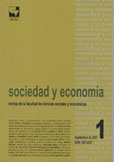Estructura espacial y ordenamiento del territorio en la macro-cuenca de los ríos Magdalena y Cauca
Keywords:
Jerarquías urbanas, macro-regiones, causación acumulativa, aglomeraciones, ordenamiento territorial, ordenamiento ambiental.Main Article Content
This study analyses the principal socioeconomic and demographic characteristics of cities in the Magdalena and Cauca river valleys of Colombia with emphasis on regional disparities. The cities in the study show profound disparities in their acquired potential for future development. The areas most retarded are highly disadvantaged in terms of their ability to compete within the framework of an open economy and internationalization. The study supports the Myrdal hypothesis of accumulative causes and is in accord with recent studies in economic geography. The article concludes by presenting criteria with respect to indicators of sustainability that are considered important in regional planning in order to alter the pattern of inequalities in development potential. The aim being to improve the welfare and living standards of future generations.
Downloads

This work is licensed under a Creative Commons Attribution-NonCommercial 4.0 International License.
Revista sociedad y economía editada por la Facultad de Ciencias Sociales y Económicas de la Universidad del Valle se encuentra bajo una Licencia Internacional Creative Commons Atribución - No comercial 4.0
Basada en una obra en http://sociedadyeconomia.univalle.edu.co

